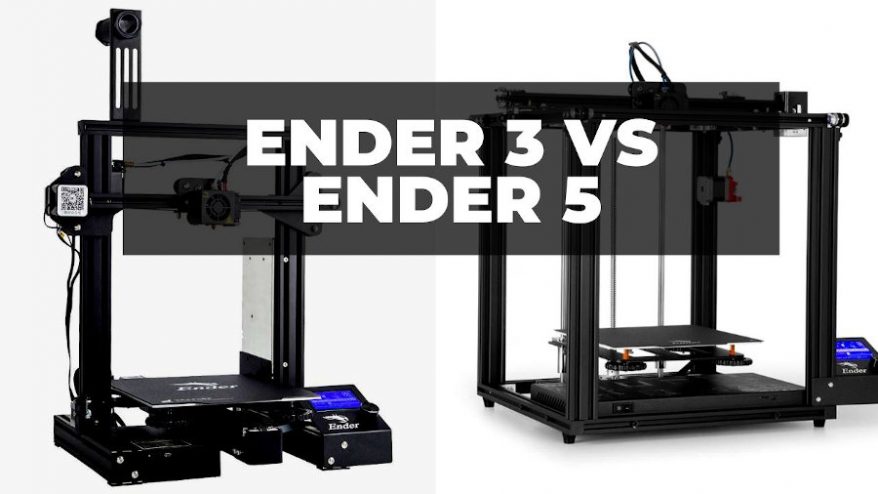
Despite only being founded in 2014, Creality has already become a household name in 3D printing. Their low-budget, high-performance 3D printers have been the talk of 3D printing communities since their release, solidifying their status as a go-to for many 3D printing enthusiasts.
3D printers such as the Ender 3 are also open-source and very upgradable — you can add auto-leveling kits, a laser engraver, and so many more general quality-of-life-improving elements to your Creality 3D printers.
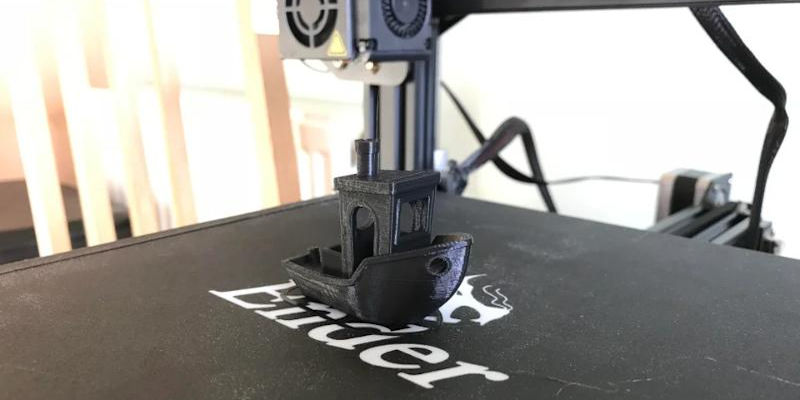
Naturally, they had nowhere to go but up, and so got to work and released further updated and tweaked resin printers over time. Later, the Ender 5 released, a new model that came with a larger price tag.
In my experience, the question of Ender 3 vs Ender 5 comes down to price.
If you have the money, go for the Ender 5. It has a larger build area, upgraded safety features, and is far easier to assemble for beginners.
That said, if you’re on a tight budget, the Ender 3 is still an impressive machine that will produce high-quality prints. It’s also easy to upgrade if you decide you need extra functionality as you tackle more advanced projects.
In this guide, I’ll share all the differences I’ve found between the two most popular Creality Ender models to help you decide which is right for you.
BUDGET PICK
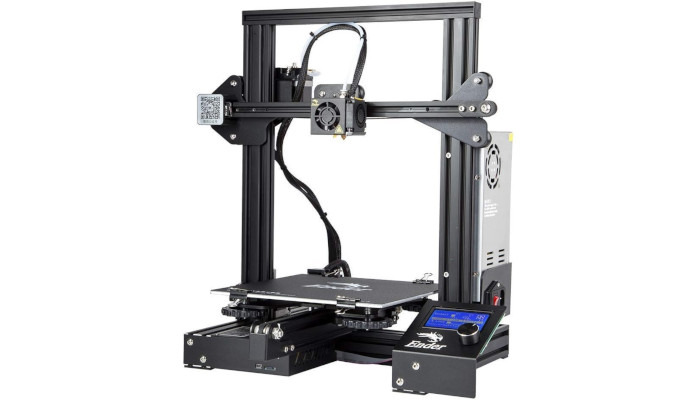
Ender 3
Available at:
TOP PICK
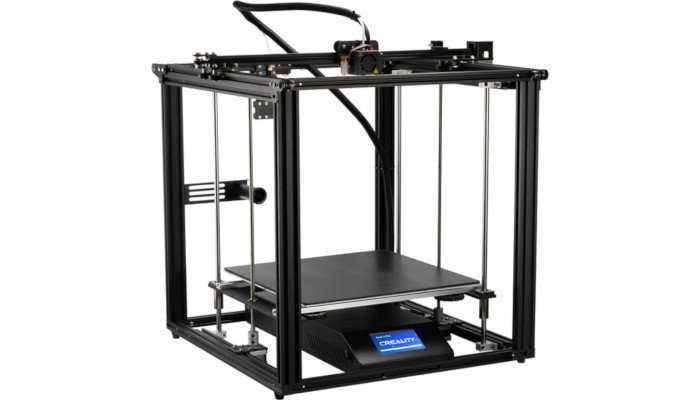
Ender 5
Available at:
Ender 3 vs Ender 5 – Need to Know
Known as one of the most popular low-cost 3D printers today, the Creality Ender 3 is an affordable but very capable machine that soon became the benchmark for hobbyists all over the world.

Because it’s open-source, the Ender 3 has become well-known for its various community-shared modifications, too. Add-ons and non-official Ender 3 upgrades have made it the tinkerer’s dream in 3D printing.
For a prime example, you can check out our article on your options for Ender 3 laser engraver upgrades.
By now you’re probably asking yourself the same question many of us have. If the Creality Ender 3 is such a powerhouse, then why pay more for the Ender 5?
The simple answer to this question is the Ender 5’s biggest draw, namely its much larger build volume.
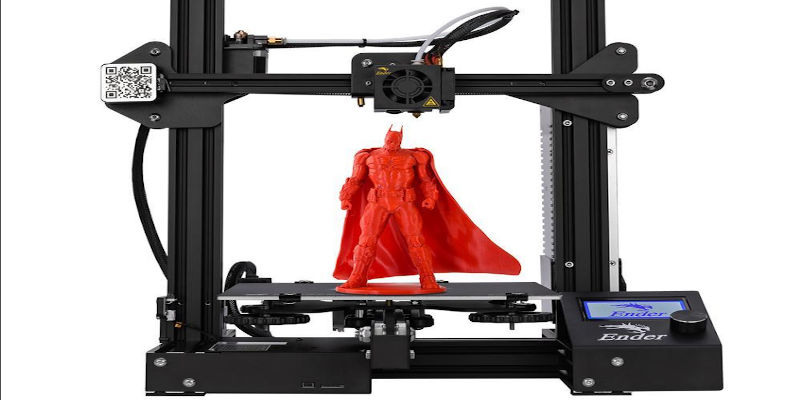
Where the Ender 3’s build volume is 220 x 220 x 250mm, the Ender 5 has a larger Z axis, giving it a build volume of 220 x 220 x 300 mm. While this may not seem like a massive change on paper, it does put the Ender 5 in a league of its own with print potential.
If you’ve already got experience with 3D printing, you’ve likely come across prints or projects that you either need to scale down or abandon altogether due to build volume limitations. In this regard, The Creality Ender 5 leaves almost no project behind.
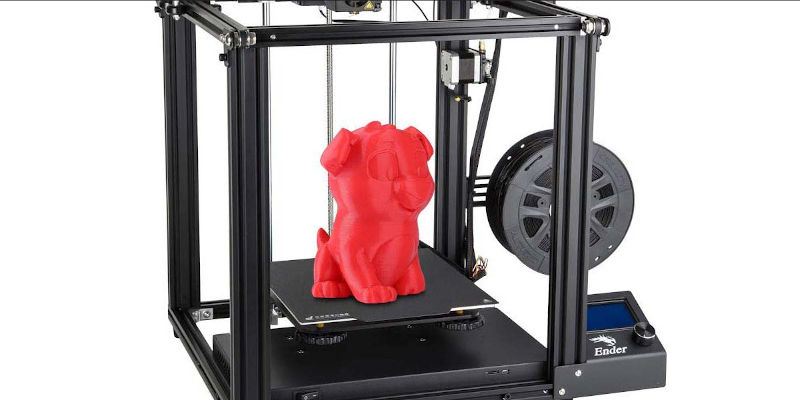
As well as this larger build volume, the Ender 5 is also capable of more complicated prints due to its advanced nozzle movements. While still attached to the central beam of the printer, the Ender 5’s hot end can move along the XY plane as opposed to simple X, Y, or Z movements.
This allows for not only more accurate models due to diagonal movements, but also faster print times by avoiding negative space.
Assembly
- Ender 3 – 2-3 hours
- Ender 3 V2 – 30 minutes
- Ender 3 S1/S1 Pro – 30-45 minutes
- Ender 5 – 30 minutes
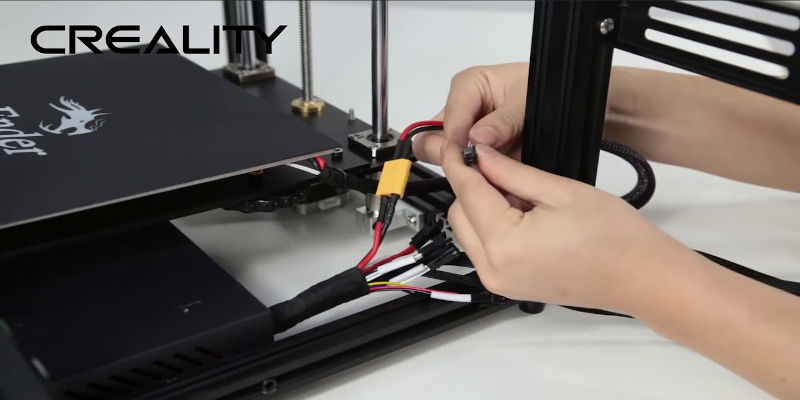
The assembly process is where we see the starkest difference between the two printers.
The Ender 3 ships as more or less a kit with an array of parts that need joining and fixing together to construct the printer. Shoddy instructions don’t help matters here (fortunately YouTube is awash with build guides to help you) and could cause quite a few stumbles for beginners building their first printer. Expect to spend at least 2-3 hours grappling with the parts before the Ender 3 is ready to print.
With subsequent Ender 3 models, namely the Ender 3 V2 and the latest Ender 3 S1/S1 Pro duo, Creality has greatly simplified the process and cut down on build times to match those of the Ender 5.
Over to the Ender 5 and we have a much more streamlined experience. It arrives semi-assembled and only requires a handful of steps and some light screw work to complete. The manual is clear and concise, allowing you to complete the build in a swift half hour.
If you’re looking for simplicity and a smooth assembly process, the Ender 5 is the winner. If you don’t mind getting stuck in and learning a whole lot about the pieces that make up your printer, the Ender 3 is a challenging, but valuable learning experience.
Build Volume
- Ender 3 – 220 x 220 x 250 mm
- Ender 5 – 220 x 220 x 300 mm
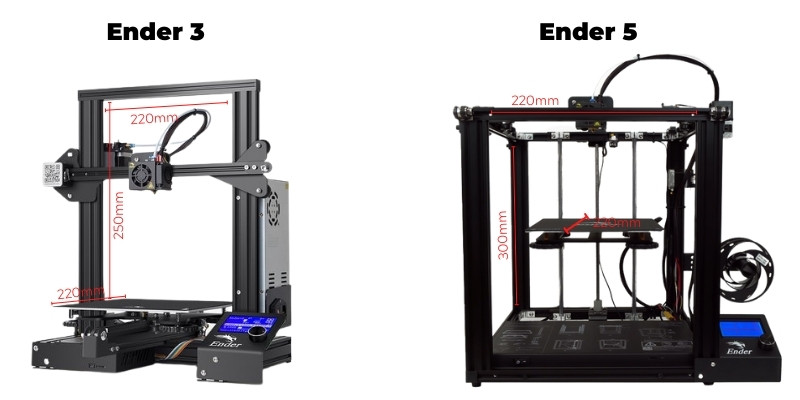
The Ender 3 has a 220 x 220 x 300 mm build volume, while the Ender 5 comes in a little larger on the Z-axis with a 220 x 220 x 250 mm build.
On paper, the difference equates to a 50 mm vertical difference. Whether this matters comes down to whether you’ll make use of that extra vertical capacity, but we wouldn’t recommend favoring the Ender 5 over the Ender 3 solely because it offers a small print area boost.
There are other considerations to keep in mind, notably price, a front on which the Ender 3 beats out the Ender 5.
The Ender 3 likely still offers plenty of room for the overwhelming majority of amateur projects, especially if you’re just starting out with 3D printing. Chances are you won’t ever make full use of the entire build volume.
In other words, if you can print it on the Ender 5, you’ll be able to do the same on the Ender 3 – those 50 mm are negligible for most users.
Heated Bed and Nozzle Temperature
Ender 3:
- Max nozzle temp: 255°C
- Max bed temp: 110°C
Ender 5:
- Max nozzle temp: 260°C
- Max bed temp: 110°C
As you can see above, there’s not much separating the two printers when it comes to max nozzle and heated bed temperatures.
The Ender 5’s ability to offer an extra 5°C nozzle temperature gives you a bit more headroom to experiment with heat-sensitive materials, but much like build volume, the difference is marginal.
It’s also worth noting that if you go for the latest Ender 3 model, the Ender S1, you’ll get identical nozzle and bed temperatures as the Ender 5.
Should you really want to experiment with exotic and more demanding materials, there’s also the Ender 3 S1 Pro, which offers a 300°C max nozzle temperature alongside the same 110°C maximum bed temperature.
Filament Compatibility
- Ender 3 – PLA, ABS, TPU, PETG
- Ender 5 – PLA, ABS, TPU, PETG

Let’s not beat around the bush here: like most manufacturers, Creality loves to burnish its marketing material by mentioning materials the machines can theoretically handle – but the best filaments for the Ender 3 and Ender 5 are definitely PLA and PETG.
To achieve print success using ABS, an enclosure is a must have to ensure the table thermal conditions the filament needs. As we know, neither the Ender 3 and Ender 5 have an enclosure as standard, though it’s possible to build or buy one, at which point both machines perform admirably printing ABS.
- The Best Ender 3 Enclosures (Pro/V2): Buyable & DIY Options
- The Best Ender 5 Enclosures (and Pro / Plus): DIY & Ready to Buy
As for TPU, it’s possible to print this flexible filament on both machines, but the Bowden extruder setup of both machines can cause all manner of headaches – jams, clogs, slips, and extremely temperamental retraction performance. Unless you’re willing to make some targeted upgrades to adapt the printers, TPU is best left alone.
All in all, the Ender 3 and Ender 5 are on par with one another when it comes to filament compatibility.
Modifiability & Upgrades
Creality earned its fame by having fully open-source hardware and firmware, even making their full specs available to anyone who wants them. Both official and non-official upgrades and modifications are all over the internet for both models.
These include laser engravers, bed levelers, silencers, and dual Z-axis upgrades to name a few.
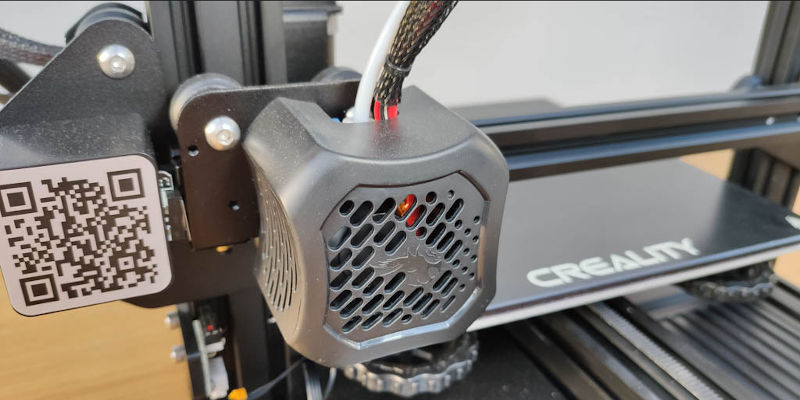
Because the size and capabilities of the Ender 3 and Ender 5 differ, you will need to make sure that the modification you’re getting applies to your machine. There’s nothing worse than putting together an auto-leveler only to realize it’s the wrong size.
As 3D printers go, few machines are quite as well suited to upgrades and modifications as the Ender series.
It channels the DIY and open-source spirit, allowing users to easily change and tweak virtually every aspect of its hardware. The internet is positively plastered with both free and paid options for both Ender 3 upgrades and Ender 5 upgrades.
And if you’re not interested in customization, skip this section, as we’re going to go into more depth here about the specific upgrades available for both the Ender 3 or Ender 5.
Dual Extruder Upgrades

- DIY Chimera – This upgrade blends the popular E3D Chimera upgrade with the Ender 3 to transform it into a bonafide dual extruder workhorse.
- Palette – a paid for upgrade, the Palette is an add-on filament splicer that allows you to mix and match colors and material types. It’s compatible with both the Ender 3 and Ender 5.
Direct drive
- E3D Hemera Direct Drive Kit – a frictionless Ender 3 direct drive upgrade from the competent folks over at the E3D, the Hemera kit includes everything you’ll need to set the Ender 3 to print flexible filaments.
- E3D Titan – over the E3D once again, this time with a direct drive upgrade suited to the Ender 5. A quality product that won’t cost an arm and a leg.
Check my full guide to the best Ender 3 Direct Drive Upgrades for more options.
Hot ends

- Micro Swiss All-Metal Hot End – An extremely popular option among DIYers – simple, effective, and reliable.
- E3D V6 All-Metal Hot End – Widely regarded as one of the best hotends in 3D printing.
- Creality Spider High-Temperature Hot End – An affordable option from Creality that’s guaranteed to play nice with both the Ender 3 and Ender 5.
- Phaetus Dragonfly BMS – A left-field option that’s gaining popularity.
For more options, check my Ender 3 Hot End Upgrades guide
Ender Extenders
There’s really only one company worth considering for an Ender 3 and Ender 5 extension – Ender Extender.
Ender 3:
- Ender Extender 400 Z Height Kit – Boost the build volume to 220 x 220 x 400 mm.
- Ender Extender 500 Z Height Kit – Extends the build volume to 220 x 220 x 500 mm.
- Ender Extender 300 – Increases the build volume to 300 x 300 x 250 mm.
- Ender Extender 300XL – Ups the build volume to 300 x 300 x 400 mm.
- Ender Extender 400 – Changes the build volume to 400 x 400 x 250 mm.
- Ender Extender 400XL – Increases the build volume to 400 x 400 x 500 mm
Ender 5:
- Extender 5 XL With Dual Z Kit – Boost build volume to 220 x 220 x 500 mm.
Auto Bed Leveling
- BLTouch Auto Bed Leveling Sensor – the king of third-party automatic bed leveling upgrades, the mighty BL Touch pairs beautifully with both the Ender 3 and Ender 5.
- Creality CR Touch Auto Bed Leveling – Creality’s answer to the BL Touch and a reliable automatic bed leveling option perfectly suited to the Ender 3 and Ender 5.
If you’d rather side step a hands-on automatic bed leveling upgrade, there’s also the Ender 3 S1, Ender 3 Neo, and soon-to-be-released Ender 5 Neo printers, which all have Creality’s CR-Touch ABL probe installed as standard.
Check out my full guide to the Ender 3 Automatic Bed Leveling Upgrades with more choices.
Fan Upgrades
Cooling Fans:
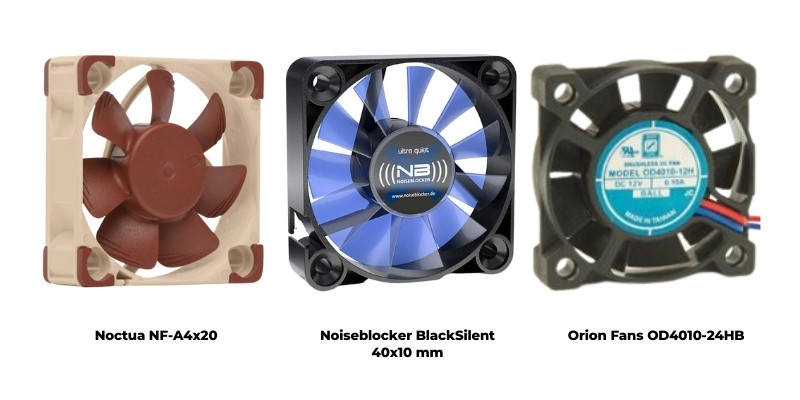
- Noctua NF-A4x10 – Premium quality, near-quiet fan.
- Noctua NF-A4x20 – Premium quality, near-quiet fan.
- Noiseblocker Black Silent 40 x 10 mm – Reliable and ultra-silent.
- Orion OD4010-24HB – Better airflow for slightly higher noise output.
Fan Ducts:
- Petsfang – A go-to design for many tinkerers looking for an Ender 3 and Ender 5 cooling fan upgrade.
- Hydra – 3D printed fan duct system with height adjustment options for both Ender 3 and Ender 5.
Hotend Fan:
- Sunon MF40202V2-1000U-A99 – 40 x 20 mm, powerful airflow, and reasonably low sound output for the performance.
- Noctua NF-A4x10 – 40 x 10 mm, extremely quiet, but requires a buck converter.
- Noiseblocker Black Silent 40 x 10 mm – 12 V, very reliable, buck converter required.
Mainboard Fan:
- Orion OD4020-24MB – 24V, strong airflow at the cost of a bit more noise.
- Noctua NF-A4x10 and Noctua NF-A4x20 – 12 V, ultra-silent, buck converter required.
- TH3D 40mm Sealed Bearing Fan – 24 V, solid, low noise fan that’s a great drop-in replacement.
See my post on the best Ender 3 Fan Upgrades for more.
Enclosures
DIY Enclosures:
Exercise and Kids Mats – An ultra budget option that works surprisingly well to keep temperatures around the Ender 3 and Ender 5 stable.
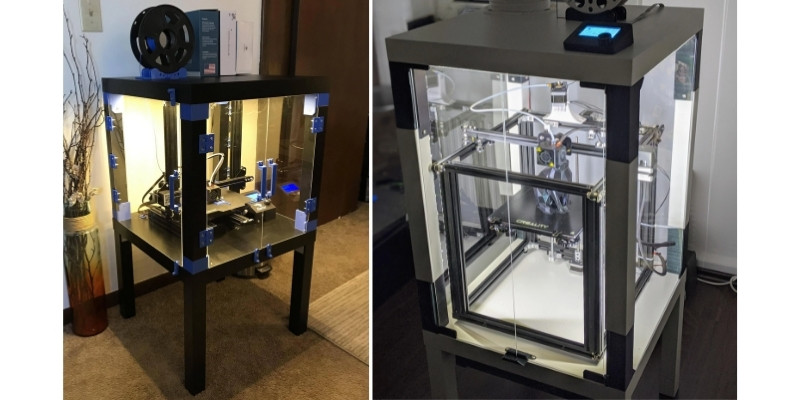
IKEA LACK Table – A 3D printing DIY classic that’s affordable and highly customizable.
Manufactured Enclosures:
- Official Creality Ender 3 Enclosure – A Creality-manufactured enclosure that’s affordable, reliable, and compatible with the Ender in all its guises. Perfect for ABS printing.
- 3D UpFitters Ender 3 Enclosure – A premium option for 3D UpFitters, this enclosure features see-through panels and an array of optional add-ons. There’s an Ender 3 version and Ender 5 version available.
Reliability
Getting any new tech, be it hardware or software, should involve looking into just how reliable it is. Program crashes can lose many work hours, and an unreliable piece of hardware can damage a machine or even come with some dangerous risks.

Both the Creality Ender 3 and Ender 5 have different features that help keep your mind at ease.
The Ender 3’s hot end is Creality’s own MK8, while the Ender 5 sports the upgraded MK10. This means that the Ender 5 is less likely to succumb to print- and machine-damaging clogs and jams.

The general design of the Ender 5 was also improved to allow the parts to move more freely without clashing. Effectively, this means the Ender 5 has a longer shelf life since the parts won’t damage each other through time and use, and the prints are more likely to come out as their intended shape.
The heated beds used in both models are the same, but the Ender 5’s has been slightly adjusted for its size and doesn’t scrape or bump against the other parts, increasing the chances of successful prints.
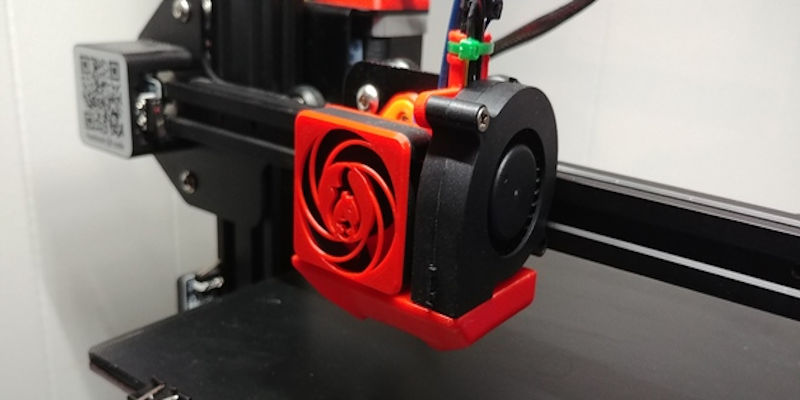
The key difference here is the springs under the bed. The Ender 5 sports Uxcell springs, which are far more reactive to pressure than the Ender 3’s more garden-variety springs, and make automatic bed leveling a less commonly needed task.
Safety Features
While the Ender 5 can be seen as a generally upgraded Ender 3, Creality has made tweaks and changes to its older models over time. Unlike the first line of Ender 3s, newer models have a fault detection system that makes sure temperature is carefully monitored and dangerous errors like clogs force quit the printing process.

The Ender 5 is also equipped with such detection, and it makes both models much safer to use. Upgrades in power supplies, nozzles, and internal wiring do make the Ender 5 much less likely to be subject to such faults in the first place.
So, while you can rest easy with both the Ender 3 and 5 in use, the Ender 5 wins out when it comes to overall safety.
Ender 3 vs Ender 5 Print Quality
Both the Creality Ender 3 and Ender 5 are capable of some truly impressive 3D prints. They are both FDM printers, which are not as known for their print quality as resin printers are, but they manage to hold their own against resin printers.
Despite the credibility that the Ender 3 has earned for high-quality prints in its relatively short life, the aforementioned axis movement upgrades of the Ender 5 give it a considerable advantage when it comes to the overall quality of its output.

Generally speaking, neither the Ender 3 nor 5 falter in print quality, but given the Ender 5’s improved movement, upgraded design so parts don’t bump together, and more reliable safety protocols, it wins overall for more consistently successful prints.
Ender 3 vs Ender 5 Price
Now here is where the crux of the Ender 3 vs. Ender 5 argument comes into play. If they are largely the same machine, then why is the Ender 5 so much more expensive?
The Ender 3 became a household name in impressive yet affordable 3D printers. At only $189 for tech that could cost you at least $500 elsewhere, it is an amazing steal even at the most advanced levels.
The Creality Ender 5 is around $269 for what could arguably be called a similar machine. The price difference between the two is clear. If your budget for something like a 3D printer is tight, you’ll definitely want the Ender 3 over the Ender 5.
Print speed
- Ender 3 – 200 mm/s
- Ender 5 – 200 mm/s
Print speed is yet another area where the Ender 3 and Ender 5 are on a level playing field. The 200 mm/s represents a theoretically maximum and it’s highly unlikely you’ll bump up the print speed that high unless you’re comfortable with a print with poor finish and shoddy overall quality.
For most amateur printing projects, 50 to 80 mm/s is widely considered the optimal range to balance out print speed and print quality.
For a deeper dive into print speeds, head to our Ender 3 Print Speed: Best Speed Settings for Ender 3 V2 & Pro guide.
Firmware
Both the Ender 3 and Ender 5 ship with a V1.1.4 Creality board.
The Ender 5 used to ship with either V1.1.2 or V1.1.3, which lacked thermal runaway protection. This meant there was always the risk of the printer heating up to unusually high temperatures due to a fault or error, enough to damage the printer or worse, cause a fire.
Though the newer V1.1.4 board takes care of the issue if you buy the printer new from a trusted reseller, we’d advise caution if you’re buying second hand.
Check the mainboard version and whether the previous owner has tinkered with the firmware to integrate thermal runaway protection or not.
For more information on firmware and the best options out there, check out our Best Ender 3 Firmware (Pro/V2): For Beginner & Advanced Users guide.
Ender 3 vs Ender 5 Summary
The Ender 5 is not so much a new or different 3D printer as it is an upgrade to the Ender 3. Because of this, the two are still largely comparable in many ways.
The Ender 5’s biggest selling point is its larger build area, though its upgraded firmware and more reliable safety features also make it a much smarter purchase than the Ender 3.
That isn’t to say that the Ender 3 is not worth it by comparison. As an FDM printer that can do so much more compared to similar machines at multiple times the price, it’s also a smart purchase for 3D printing hobbyists who are looking for a great machine without breaking the bank.
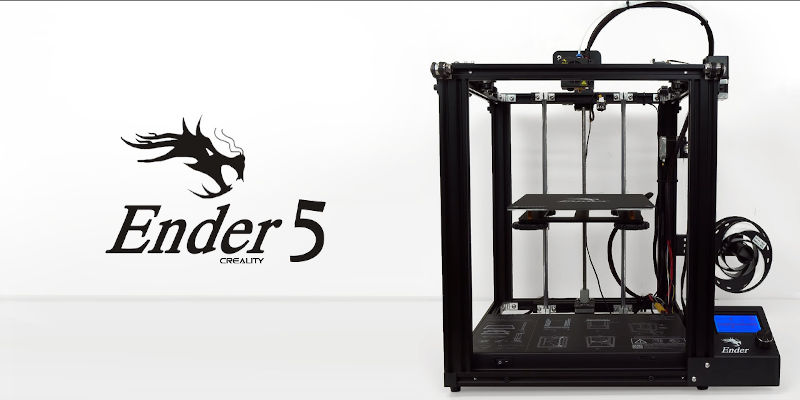
Ultimately, your decision will likely come down to the price. If money is no object, then you should absolutely go for the Ender 5 due to its undoubtedly better capabilities. However, if you really want a 3D printer but are working to a budget, you’ll be better off getting the Ender 3, which has equally impressive specs and capabilities without breaking the bank.
If you’re in a hurry to buy a 3D printer, then the Ender 3 is your best bet. But if you don’t mind saving a little more before making your purchase, then the Ender 5 is the printer for you.
Which is better Ender 3 V2 or Ender 5?
The Ender 5 is better if you prefer larger build volume to print larger projects like cosplay helmets and props, or larger prototypes. The Ender 3 V2 is better if you want a reliable 3D printer under $300 that prints consistently and to a high quality.
Read more: the Ender 3 V2 compared with the Ender 5 Pro
Which is the best Creality Ender?
The Ender 3 is Creality’s best-selling 3D printer currently, and one of the world’s best-selling 3D printers. The Ender 5 range are the next most popular, favored for larger 3D printing, and other Enders like the Ender 2 Pro, and Ender 6 are less popular than the Ender 3 and Ender 5.
BUDGET PICK

Ender 3
Available at:
TOP PICK

Ender 5
Available at:
Other articles you may be interested in:




